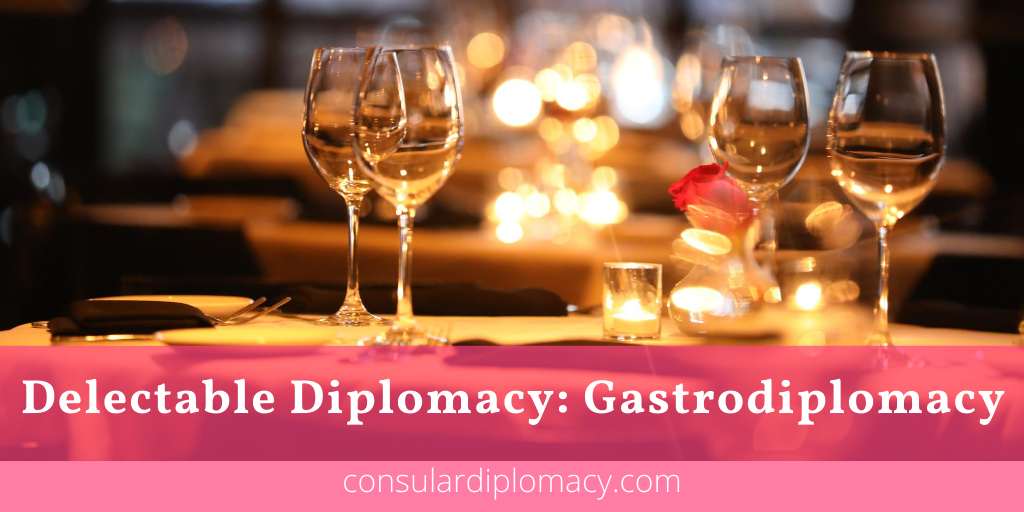 The third component of the new kind of doing diplomacy is Gastrodiplomacy. As I mentioned in the first post, the term was created in 2002 by The Economist in an article about Thailand's efforts to “…boost the number…” of Thai restaurants around the world and “to make it easier for foreign restaurants to import Thai food…”[i] Since then, a substantial number of studies and articles about Gastrodiplomacy were created, particularly by Paul Rockower, founder of the Levantine Public Diplomacy organization. Besides, Sam Chappel -Sokol also developed what he calls “culinary diplomacy”, which is different from Gastrodiplomacy, as you will learn later on this post. The highlight of the study of winning hearts and minds through the stomach was the publication of an issue about Gastrodiplomacy in the Public Diplomacy magazine in 2014. As far as I know, from recent online searches, it seems that the term is less used nowadays. Maybe because it was a mere fad or because, as some have written,[ii] it was not real diplomacy at all, but just a tool of public/cultural diplomacy that did not deserve a particular category in the academic world. In his seminal work of 2012 “Recipes for gastrodiplomacy”, Rockower defines Gastrodiplomacy as “how countries conduct cultural diplomacy through promotion of their cuisine.”[iii] He explains that it “uses a country’s culinary delights as means to conduct public diplomacy and to raise nation brand awareness.”[iv] The author explains that Gastrodiplomacy is not only food tastings and cooking demonstrations offered by embassies, but a “ concerted public diplomacy campaign by a national government that combines culinary and cultural diplomacy – backed up by monetary investment – to raise its national brand status…”[v] Rockower also differentiates this concept from other similar ideas, like culinary or food diplomacies,[vi] citing the work done by Sam Chappel-Sokol in “Culinary Diplomacy: Breaking Bread to Win Hearts and Minds”. In the second part of the article, Rockower briefly explains the Gastrodiplomacy efforts developed by Malaysia, South Korea, Taiwan, and Thailand, as well as dwelling a bit about some people-to-people Gastrodiplomacy initiatives such as the Conflict Kitchen restaurant in Pittsburg, U.S.A (now closed). As mentioned before, the other scholar who delves into the concept of Culinary Diplomacy is Sam Chappel-Soko, who includes what Rockower defines as Gastrodiplomacy. In his article (see above), he delineates culinary diplomacy “as the use of food and cuisine as an instrument to create cross-cultural understanding in the hopes of improving interactions and cooperation.”[vii] And states that there are two types: public and private, being the former part of public and cultural diplomacy, while the latter “occurs behind closed doors.”[viii] It is interesting to appreciate that most scholarly articles about Gastrodiplomacy focus on several efforts by Asia-Pacific nations such as Thailand, South Korea, Malaysia, Japan, and Taiwan, with a few others like Peru´s Gastrodiplomacy.[ix] However, little to nothing has been written from a Gastrodiplomacy perspective about Mexico´s efforts to obtain the recognition of its cuisine as an Intangible Cultural Heritage of Humanity by the UNESCO (achieved in 2010 after a failed attempt in 2005 titled “People of Corn, Mexico´s Ancestral Cuisine”),[x] Neither about the prolonged under-the-radar Consular Diplomacy activities around Mexican food in the United States in the first decade of the new millennium. One reason could be that these activities are not considered Gastrodiplomacy, so there is no room to include them in scholarly studies and other articles. Another one could be that most of the papers and reports are written in Spanish. Additionally, it seems there has been an absence of the analysis undertaken, not just by the government, but by scholars and practitioners alike. I believe this is the real reason why the Gastrodiplomacy strategy implemented by Mexico is not well known. Therefore, one of the goals of the blog is to share with the world these efforts. You can see a few papers about this topic in the Interesting Links section. For a comprehensive list of published studies about Gastrodiplomacy, you can visit this webpage: Levantine Public Diplomacy organization. [i] The Economist, “Food as ambassador, Thailand´s gastrodiplomacy”, February 21, 2002. [ii] See Riordan, Shaun, “Stop inventing “New Diplomacies” in CPD blog, June 21, 2017; Höne, Katharina, “Would the Real Diplomacy Please Stand Up” and Brown, John, “Diplomacies from public to pubic”, Huffington Post, March 23, 2016. [iii] Rockower, Paul “Recipes for gastrodiplomacy” in Place Branding and Public Diplomacy, Vol. 8, No. 3, 2012, p. 235. [iv] Ibid. [v] Ibid. p. 236. [vi] Paul Rockover indicates that food diplomacy “…involves the use of food aid and food relief in a crises or catastrophe” in “The State of Gastrodiplomacy” Public Diplomacy Magazine, No. 11, Winter 2014, p 12. [vii] Chappel-Sokol, Sam, “Culinary Diplomacy: Breaking Bread to Win Hearts and Minds” in The Hague Journal of Diplomacy, Vol. 8, 2013, p. 162. [viii] Ibid. [ix] For a deeper analysis of the cuisine diplomacy of these six countries from an strategic communication perspective see Juyan Zhang´s “The Food of the Worlds: Mapping and Comparing Contemporary Gastrodiplomacy Campaigns” in International Journal of Communication Vol. 9, 2015, p. 568-591. [x] Interesting enough, in “Comida Peruana para el Mundo: Gastrodiplomacy, the Culinary Nation Brand and the Context of National Cuisine in Peru” Rachel Wilson recognizes that one of the main objectives of Peru´s Gastrodiplomacy effort was “having its cuisine deemed part of the United Nations Educational, Scientific, and Cultural Organization (UNESCO) Intangible Cultural Heritage of Humanity…” in Exchange: The Journal of Public Diplomacy, Vol. 2, No. 1, 2011, p. 13. DISCLAIMER: All views expressed on this blog are that of the author and do not represent the opinions of any other authority, agency, organization, employer or company.
0 Comments
Your comment will be posted after it is approved.
Leave a Reply. |
Rodrigo Márquez LartigueDiplomat interested in the development of Consular and Public Diplomacies. Archives
May 2024
Categories
All
|
